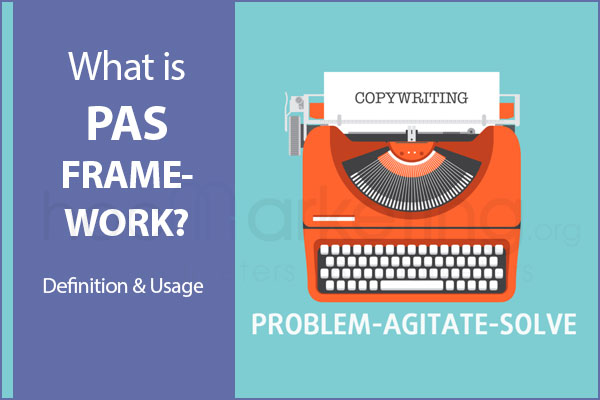
What is AIDA? How to use AIDA framework (model) in Copywriting

The AIDA framework is a copywriting model that has been around for more than 100 years. It is an excellent tool for copywriters to use in writing. This article will also cover the definition & history of the AIDA framework, how to use it in Copywriting and Marketing.
How can you create an article that is engaging, useful for customers, and especially promotes buying behavior? What you need is a formula for creating content that fits your Target Marketing and customer psychology. However, there is no single most effective formula, only the right formula. Therefore, you need to identify the target Marketing and understand the nature of each type of formula to apply it reasonably and effectively.
The AIDA framework is a copywriting model that has been around for more than 100 years. It is an excellent tool for copywriters to use in writing. The framework breaks down the process of persuading your audience into six steps which will be explained in this article. This article will provide you with basic information about the AIDA formula commonly used in copywriting and some points you need to keep in mind when applying AIDA to your writing. This article will also cover the definition & history of the AIDA framework, how to use it in Copywriting and Marketing.
What is AIDA Framework (Model)?
The AIDA framework is a model for effective advertising copywriting. It is is a formula for creating content based on the process of considering and coming to a decision of the customer. AIDA formula will turn the article into a journey to attract attention, create a feeling of interest in products/services, stimulate desire and drive action to buy products or choose services from customers. The acronym "AIDA" stands for Attention, Interest, Desire and Action - the four stages of capturing your audience's attention and getting them to take action:
- Attention: Get the reader's attention
- Interest: Stimulate curiosity and keep their interest
- Desire: Arouse wants & desires
- Action: Prompts the reader to take action
Although AIDA is not the only formula, it is a "golden formula" applied by many copywriters in the journey to build customer trust, drive consumer behavior and increase conversion rates.
Short history of AIDA Framework (Model)
AIDA Framework was invented by E. St. Elmo Lewis in 1898 when he launched a magazine called "System" aimed at business owners to help them with advertising and promotion of their products/services. The AIDA model provides a blueprint for creating an ad that will pull in the reader and make them listen - it is concerned with capturing your prospect's attention and motivating him to take action.
E. St. Elmo Lewis - AIDA Framework inventor
After the invention of AIDA, advertising agency Albert Lasker , decided to evolve the model and include the idea of "a vacuum" from which to create a desire in your prospects. In 1912, he created an ad called "The scientific monthly dinner" using the AIDA model.
In 1933, E. St. Elmo Lewis acknowledged this improvement to his model and essentially. In that year, Wilson's Business Review published a study by Professor G. Clapp that showed how different ad campaigns from the 1920s worked using the AIDA model.
In 1940, Walter Weir published "The Science of Selling", based on research showing what factors were necessary for success in selling goods and services. He used the term "attention-interest-desire-action" as a formula for achieving success. In 1950, Claude Hopkins called it the AIDASAK formula in "Scientific Advertising".
In 1972 David Ogilvy wrote an article published by Ad Age on advertising theory about how to create a sale using the AIDA model. The article was reprinted a few years later in a textbook called "Ogilvy on Advertising".
In 1979, Alvin E. Roth published "Attention-interest-desire-action: an introduction to theory and practice" which consolidated the work of Lewis, Lasker and Weir as well as developing additional tests for ads based on the AIDA model. In 1983 Gerard Tellis published "Advertising and Promotion Management" which discussed the AIDA model as well as suggesting other variables such as dL (degree of liking) and dP (desire to possess).
Nowadays, AIDA is widely used in digital marketing and advertising. Marketers create content by following the AIDA approach: grab attention, build interest, generate desire and drive action.
The AIDA Formula
The AIDA formula includes four elements: Attention, Interest, Desire, and Action.
- Attention (Grab audience's Attention): This is the stage where you need to build customer awareness of your brand. Your goal is to help them know the most basic information about products, services, and the existence of the brand.
- Interest (Generate audience's interest): Make potential customers curious and interested in what is and will be conveyed. At that time, customers will learn more about the benefits and suitability of the product/service for their life.
- Desire (Stimulate audience's desire): The goal of this phase is to develop a connection between the customer's needs and the benefits of the brand. Let them see your product / service is the most suitable choice and make them need to own the product / service immediately.
- Action (Call to Action): This is the step that determines the success of the article. Because, if you call to action immediately after capturing the customer's attention, the conversion rate will increase higher and faster.
How to use the AIDA Framework (Model) in copywriting?
Using AIDA Framework is quite easy. We are going to divide the writing into 4 sections as its name: Attract Attention - Generate Interest - Stimulate Desire - Encourage Action.
1. Attract Attention
In the first section of the writing, you have to grab the attention from readers. This is the first and most important step of all. To do that, you need research carefully about the readers and exploit there concerns. There are some popular techniques to get the readers' attention:
- Mentioning the readers' problem is one of the best way to do that. Most people are always looking for solutions to solve their problem. The more fatal the problem is, the bigger attention the readers will pay.
- Using social phenomenon is also a good way to attract readers' attention. If you can reference any popular news or hot topics, that will definitely increase the chance of your writing being read.
- Using metaphors and analogies can be a good way to attract attentions as well. The readers will tend be curious about what you want them to see after reading your article.
2. Generate Interest
After getting the readers' attention, it is time for you to keep their interest. You have to build something interesting to hold on their mind and make them feel curious and want to read more. There are some techniques that will help you accomplish that:
- Using statistics or studies can be a good way to build interest in the readers' minds. The numbers and facts will attract the attention of the readers and let them be curious about what it means.
- Quoting celebrities, authority or influencer is also a good way to build interest. When famous people say something about your writing, you have higher chances of being paid attention to by the readers.
- Using questions is another way to generate interest in the readers' minds. If you can ask any question that intrigues their curiosity or makes them feel like "I want to know more, what do you have to say about it?", they will definitely keep reading.
3. Stimulate Desire
After building your readers interested and curious, you need to stimulate their desire by giving them a full picture of the content of your writing. Try to give them some information from what they can get from your writing and make sure that the information is valuable enough to make them feel "I want it" or "I need it". You can use these techniques to stimulate desire in your readers:
- Using the word free often arouses desire in people. If you are giving something for free, such as a guide, checklist, report and etc., the users will definitely like to have it.
- Appeal to people's emotions. Emotions are powerful levers that drive human behavior. You can use happiness, joy, hope, anger to make your readers feel like they need the things you offer in the writing.
- Show scarcity and exclusivity of what you offer can also stimulate desire by making them feel like "I want it because everybody wants it but I can get it".
4. Encourage Action
In the final section of your writing, you have to tell people what they can do. You have to make a very clear call-to-action and set the next step for them in order to achieve what you promise. To make a successful call-to-action, there are some rules that you have to follow:
- Your call-to-action should include a clear and direct instruction. The more detailed the instruction, the less confusion your readers will have.
- The words 'now' and 'immediately' encourage people to take action immediately as they will feel like they don't want to lose the opportunity by delaying their action.
- The more familiar the content of your writing is, the simpler you have to make the call-to-action. If your call-to-action contains too many unfamiliar and complex words, they will not know what to do and give up easily.
- There should be a reward or benefit for taking the next step that you require your reader to take. If they can get something valuable, they will definitely feel encouraged to do what it takes. The bigger the change of getting the reward is, the easier it will be for them to take action because people usually avoid things that will cost them a lot of effort or time without getting something in return.
The Advantages of AIDA
1. Simple and easy to use
The most outstanding advantage of AIDA is its simplicity and ease of understanding. Thanks to this feature, more than 100 years later, AIDA is still favored and widely used by copywriters. For example, if you want to optimize your brand's online appearance. AIDA can help you test with the following type of questions:
- Attention: Is the site easy to find?
- Interest: Is the information describing the product, service... interesting to attract views?
- Desire: Is the overall website designed in an impressive way that makes customers trust and want to buy the product?
- Action: Are call-to-action elements cleverly integrated into the content to remind and urge viewers to take action?
2. Deep, persuasive content
Vì công thức AIDA được xây dựng dựa trên hành trình ra quyết định của khách hàng nên khi viết, Copywriter cũng trải nghiệm hành trình ấy và dễ dàng tìm ra được những lợi ích ở thương hiệu mà khách hàng mong đợi. Đồng thời, nội dung sẽ trở nên gần gũi với suy nghĩ của khách hàng và thể hiện sự tinh tế của thương hiệu khi thấu hiểu được tâm lý khách hàng.
Hệ thống ý tưởng được sắp xếp theo AIDA không chỉ thể hiện được thông điệp một cách rõ ràng mà còn thể hiện sự đồng cảm của thương hiệu đối với tâm lý khách hàng. Một khi khách hàng cảm nhận được sự đồng cảm ấy, họ sẽ an tâm và cân nhắc quyết định chọn sản phẩm/dịch vụ.
3. Increase conversion efficiency
Although the AIDA formula does not call customers to take action from the very first line, the reminder in the "Action - Encourage action" step is the "bottom line" to help increase the conversion rate for the article. The context of "Attracting attention - Creating excitement - Arousing desire - Encouraging action" helps customers both have time to learn, consider information about products/services, and be guided. How to contact to purchase or register to use the service. Therefore, in the process of viewing content, customers can fully feel the brand's message.
4. Time-saving
Like other content writing formulas, AIDA has pre-designed steps to help copywriters easily find ideas and organize content logically. In particular, each step in AIDA is a stage in the customer's decision-making process, so this formula also helps writers ensure that the content is more closely related to customer psychology and behavior. From there, time spent on checking and adjusting content is also saved.
The limitations of AIDA
AIDA Framework is a good writing model. Its effectiveness has been proven by many copywriters in many years. However, like any other model or system, it also has its own limitations.
1. It takes many steps
Compared to PAS - a formula for persuading customers based on the desire to solve problems, AIDA requires writers to perform more convincing stages. When applying the AIDA formula, you will act as a customer and experience all 4 steps in the buying decision journey. On the other hand, you still have to ensure the brevity, avoiding going around and making viewers feel bored.
2. Lack of breakthrough if you abuse AIDA
Just like other content creation formulas, if you only apply the same formula to every form of advertising, the brand story will lack creativity and the content will lack breakthrough ideas. In addition, approaching customers with an iterative method will gradually make them lose interest in your content. Because new unique content can more easily capture the attention of viewers, you need to constantly innovate the way you reach customers by adjusting elements of your written formula or changing the recipe. suitable for the form of advertising and communication.
3. Lack of customer retention factor
AIDA has a very simple structure, focusing on only 4 stages. But to compete with other brands, you need to build a loyal customer base and invest effort to satisfy customers even after using the product/service. This is what AIDA lacks.
4. It cannot guarantee that the buyers will choose the company's products/services as their solution.
AIDA has done well in stimulating desire and encouraging action from readers. However, it cannot guarantee that the buyers will choose the company's products/services as their solution. Consumer buying behaviors are always complicated and hard to predict. They may choose the product of competitors, other solutions or even nothing. Thus, it is important to remember that you should not rely on AIDA framework only when offering your products/services because there are other things that influence consumer buying behaviors.
5. It's hard to produce unique writing.
AIDA has been used for years by copywriters, so the standard of using AIDA has been formed over time. The problem is that many writers have to follow the standards in order to achieve what they want, which results in similar or even identical writings between different writers. Thus, it is hard for writers to produce unique or stand-out writing.
6. AIDA Framework cannot cover bad writing skills.
AIDA Framework is just a tool. It can only serve the purpose when it is used by skillful copywriters. If you are not that good in writing, AIDA will just waste your writing because people won't read until the end of your article or they even get irritated before finishing reading the first paragraph due to bad writing skills.
Conclusion
AIDA framework is a good tool to help you write copy. However, it does have limitations of its own that are worth considering before relying on the model for all your writing needs. If you struggle with bad writing skills or want more unique content, AIDA may not be right for you. That doesn't mean you should stop using it altogether though! It can still serve as an effective way to stimulate desire and encourage action in your readers.



















